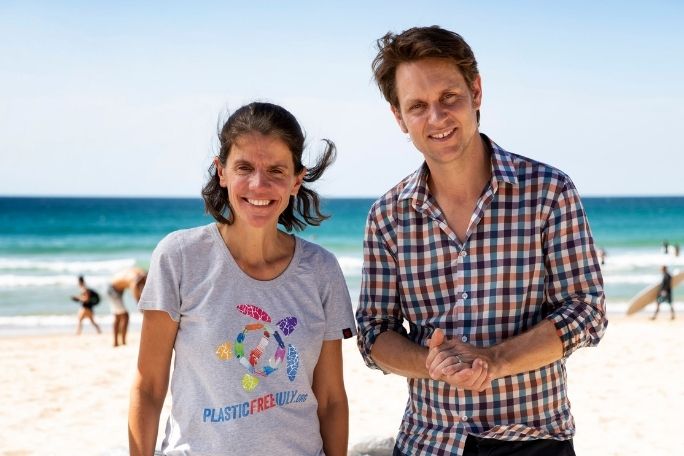Lesson summary
Students explore the problem of plastic waste in our oceans. They begin by exploring their prior knowledge by creating a mind-map around the term ‘plastic waste’. They then conduct a SEE THINK WONDER activity around an image from War On Waste before finding out how plastic waste harms marine life. Students then view and reflect on a range of artworks that have been created in response to the problem of plastic waste in our oceans, and are scaffolded to draft and create their own artwork around this problem.
Learning intentions:
Students will...
- understand how plastic waste can impact marine life
- understand how art can be used to inspire people to take action on an issue.
Success criteria:
Students can...
- think critically about plastic waste pollution
- analyse and interpret the meaning of artworks and visual conventions used
- draft and create artworks
- participate in group discussions.
Lesson guides and printables
Lesson details
Curriculum mapping
Australian curriculum content descriptions:
Foundation Science:
- Objects are made of materials that have observable properties (ACSSU003)
- Share observations and ideas (ACSIS012)
Year 1 Science:
- Everyday materials can be physically changed in a variety of ways (ACSSU018)
- Represent and communicate observations and ideas in a variety of ways (ACSIS029)
Year 2 Science:
- Different materials can be combined for a particular purpose (ACSSU031)
- Represent and communicate observations and ideas in a variety of ways (ACSIS042)
Year 3 Science:
- Science knowledge helps people to understand the effect of their actions (ACSHE051)
- Represent and communicate observations, ideas and findings using formal and informal representations (ACSIS060)
Years F to 2 Visual Arts:
- Explore ideas, experiences, observations and imagination to create visual artworks and design, including considering ideas in artworks by Aboriginal and Torres Strait Islander artists (ACAVAM106)
- Use and experiment with different materials, techniques, technologies and processes to make artworks (ACAVAM107)
- Create and display artworks to communicate ideas to an audience (ACAVAM108)
- Respond to visual artworks and consider where and why people make visual artworks, starting with visual artworks from Australia, including visual artworks of Aboriginal and Torres Strait Islander Peoples (ACAVAR109)
Year 3 Visual Arts:
- Use materials, techniques and processes to explore visual conventions when making artworks (ACAVAM111)
- Present artworks and describe how they have used visual conventions to represent their ideas (ACAVAM112)
- Identify intended purposes and meanings of artworks using visual arts terminology to compare artworks, starting with visual artworks in Australia including visual artworks of Aboriginal and Torres Strait Islander Peoples (ACAVAR113)
Syllabus outcomes: STe-9MEm, STe-4WS, ST1-12MW, ST1-4WS, ST2-11LW, ST2-4WS, VAS1.1, VAS1.2, VAS1.3, VAS1.4, VAS2.1, VAS2.2, VAS2.3, VAS2.4
General capabilities: Critical and Creative Thinking
Cross-curriculum priority: Sustainability OI.8, OI.9
Relevant parts of Foundation Science achievement standards: Students describe the properties and behaviour of familiar objects, and share and reflect on observations
Relevant parts of Year 1 Science achievement standards: Students describe objects and events that they encounter in their everyday lives, and sort their observations and share them with others
Relevant parts of Year 2 Science achievement standards: Students identify that certain materials and resources have different uses, and communicate ideas in a variety of ways
Relevant parts of Year 3 Science achievement standards: Students describe how they can use science to respond to questions and they communicate their ideas
Relevant parts of Foundation to Year 2 Visual Arts achievement standards: Students describe artworks they make and view and where and why artworks are made and presented. They make artworks in different forms to express their ideas, observations and imagination, using different techniques and processes.
Relevant parts of Year 3 Visual Arts achievement standards: Students discuss how they and others use visual conventions in artworks. They plan and make artworks that are inspired by artworks they experience. They use visual conventions, techniques and processes to communicate their ideas.
This lesson is part of the wider unit of work: War On Waste – Foundation to Year 3
Time required: 60 mins
Level of teacher scaffolding: Medium – facilitate class discussion, oversee art analysis and art-making activities
Resources required
- Art-making materials
- Device capable of presenting a video to the class
- Plastic Pollution Factsheet
- Plastic Waste Artwork Images
- Plastic waste items (can be collected by students during creation of artwork)
- OPTIONAL – Student Worksheets – one copy per student
Skills
This lesson is designed to build students’ competencies in the following skills:
- Communication
- Creativity
- Critical thinking
Additional info
Cool Australia’s War On Waste lessons have been developed in partnership with Lune Media and with support from the Australian Environmental Grantmakers Network. These lessons have been designed to lead students through a deeper understanding of some of the big issues relating to waste in Australia and to support them to take action to reduce the impact of waste on our environment.


Welcome back!
Don't have an account yet?
Log in with:
By signing up to Cool.org you consent and agree to Cool's privacy policy to
store, manage and process your personal information. To read more, please see
our privacy policy here(Opens in new tab).
Create your free Cool.org account.
Many of our resources are free, with an option to upgrade to Cool+ for premium content.
Already have an account?
Sign up with:
By signing up to Cool.org you consent and agree to Cool's privacy policy to
store, manage and process your personal information. To read more, please see
our privacy policy here(Opens in new tab).